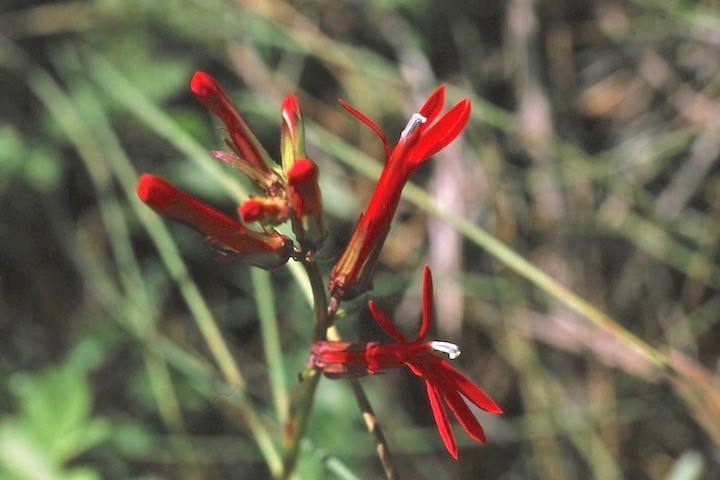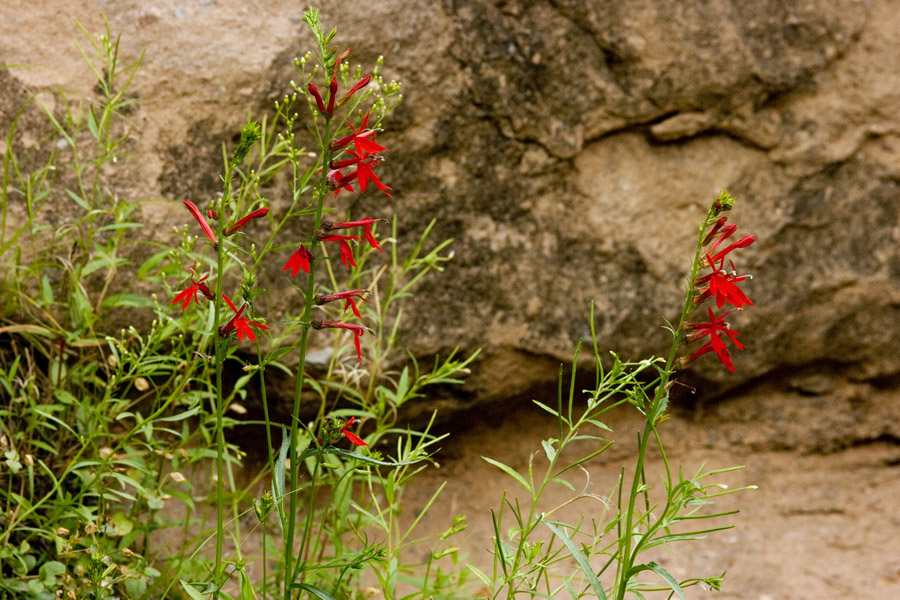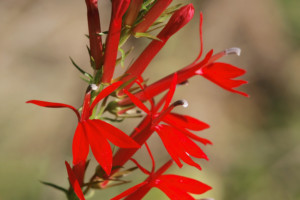Scientific name: Lobelia cardinalis
Common name: cardinal flower
Family: Campanulaceae
Article by Jeanne Gozigian
When I first started volunteering as a docent at the Leonora Curtin Natural History Area (now the Leonora Curtin Wetland Preserve, LCWP) outside of Santa Fe in La Cienega, New Mexico, our prize plant specimen was a lone cardinal flower. It grew in the middle of a meadow area in a seep, just before the seep became a small, permanent stream in the rare, steppe wetland. A seep, according to the Merriam Webster Dictionary, is a place where liquid contained in the ground flows or slowly leaks through porous material, often forming a pond.

Lobelia cardinalis (Photo by Barb Goede).
Every year, all of us docents waited anxiously to see if our beloved Lobelia cardinalis would return for another season. The last known photograph of the beauty was taken by Barbara Goede, a wetland docent, in the summer of 2007. We do not know why it failed to grow or bloom again.
Perhaps the water table became a bit too low – the plant likes to have wet feet and grows in swampy areas. The most impressive stand of cardinal flowers that I have ever seen was in a willow patch off a trail in the Big Bend National Park, on the Texas/Mexico border. Profuse red flowers were blooming in what looked like a pond. Perhaps the temperatures were a bit too high at LCWP in 2008. We just know that our prize plant disappeared, never to be seen again. So it was with a great deal of nostalgia that I approached the research for the June “Plant of the Month” article.
Lobelia cardinalis (lo-BEE-lee-ah kar-din-AL-iss) has tubular, showy red blossoms on an elongated cluster. I find that interesting, in that the Campanula family often has bell-shaped flowers, e.g., tall blue bells (Campanula americana), lovely blue flowers which also grow in wet places. Campanula has been defined as “little bell shaped” in Dave’s Garden website, Botanary. The language of flowers – florigraphy- says that Campanula stands for gratitude.

Photo by Patrick Alexander. Lobelia cardinalis, Purgatory Chasm Trail, east of Lake Roberts on NM Hwy 35, Grant County, New Mexico, 23 Aug 2009.
This short-lived, perennial herb (maybe this is what caused our LCWP specimen to disappear?) loves to grow in very moist, hummus rich soil in USDA zones 3-9. In climates with colder winters, root mulch will help to protect the plants and will retain soil moisture in all conditions. It likes full sun but will tolerate part shade. It blooms from July through September as racemes on erect stems with a height of 2-4 feet but can be up to 6 feet. Dark green, finely-toothed, alternate, lance-shaped leaves can be 3-8 inches long.
Lobelia cardinalis is named in honor of Matthias de l’Obel (1538-1616), a French physician (another of a famous group of physician/botanists!), he was the personal physician to James I of England. He wrote Stirpium Adversia Nova – 1570, with Pierre Pena. They posited a plant classification system based on leaves. Cardinalis – cardinal red – refers to the red robes worn by Catholic cardinals. White flowers can occasionally occur.

Lobelia cardinalis, Sycamore Canyon, 8/7/05. Photo by Patrick Alexander.
The long tubular flowers have two upper lips with three, more prominent lower lips. The shape of the blossoms makes it difficult for insects to navigate, so they are dependent on hummingbirds and butterflies for pollination. Propagation is best achieved using seeds, available from the Native Seed Network. Success in raising these lovely flowers is boosted by three –month- long cold stratification of the seeds.
Indigenous people developed medicinal uses for cardinal flowers, as they did most native plants. Teas made from infusions of the roots were thought to be effective for stomachache, syphilis, typhoid and worms. Like many other native plants, L. cardinalis is toxic if taken in large quantities, due to alkaloids and volatile oils present in the entire plant. Some sources say that all parts of the plant are seriously toxic.
I wonder if cardinal flowers could be reintroduced to LCWP? I think that all of the wetland docents would love to see it come home again. Wildflowersnm.com does not include Santa Fe County on its range map for Lobelia cardinalis. Was this why it disappeared? We hope not.
Thanks to Janice Tucker and Helen Woody for proof reading this article.
Sources:
“Campanula americana”. Plant Finder. Missouri Botanical Garden. Web. 28 May 2019. Retrieved from: http://www.missouribotanicalgarden.org/PlantFinder/PlantFinderDetails.aspx?taxonid=278797.
“Cardinal flower.” Wildflowers of New Mexico. Web. 28 May 2019. Retrieved from: http://www.wildflowersnm.com/Wildflowers_of_New_Mexico/Lobelia_cardinalis.html.
Harrison, Lorraine. Latin for Gardeners, The University of Chicago Press, 2012.
“Lobelia cardinalis”. Native Plants Database. Lady Bird Johnson Wildflower Center. 6 Apr. 2017. Web. 28 May 2019. Retrieved from: https://www.wildflower.org/plants/result.php?id_plant=LOCA2.
“Lobelia cardinalis”. Plant Finder. Missouri Botanical Garden. Web. 28 May 2019. Retrieved from: http://www.missouribotanicalgarden.org/PlantFinder/PlantFinderDetails.aspx?taxonid=278870
Native Seed Network. Institute for Applied Ecology. Web. 28 May 2019. Retrieved from: http://nativeseednetwork.org.
“Cardinal flower”. The Plant Guide. Fine Gardening. Web. 28 May 2019. Retrieved from: https://www.finegardening.com/plant/cardinal-flower-lobelia-cardinalis.
“seep”. Merriam-Webster.com. Merriam-Webster, 2019. Web. 28 May 2019.
Stearn, William T., Stearn’s Dictionary of Plant Names for Gardeners, Cassell Publishers, Limited, London, 1992.


